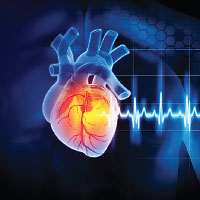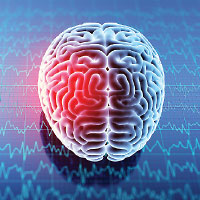Journal Digest: Cardiac Death and Schizophrenia, TBI-Emergent Mania, and More
Sudden Cardiac Death in Schizophrenia Patients Driven by Multiple Factors

Multiple factors may contribute to the increased risk of sudden cardiac death in patients with schizophrenia, a study in JACC: Clinical Electrophysiology has found.
A team led by researchers at the Baker Heart and Diabetes Institute in Prahran, Australia, examined forensic data on 579 people aged 15 to 50 years who had died from cardiac arrest between April 2019 and April 2021; 65 (11%) of these people had schizophrenia. (For comparison, the prevalence of schizophrenia in the general population is about 1%).
Compared with people without schizophrenia, those with a medical history of schizophrenia were more likely to be smokers than those without schizophrenia (46.2% versus 23.0%), more likely to drink more alcohol than national recommendations (32.3% versus 21.4%), and more likely to have been taking QTc-prolonging medications (69.2% versus 17.9%).
In addition, people with schizophrenia were far more likely to have a cardiac arrest without witnesses (6.2% vs 23.5%), which decreases the odds of resuscitation. On average, patients with schizophrenia who experienced cardiac arrest were not found until multiple hours after their death, typically as part of a welfare check.
“Optimizing cardiovascular health in people with schizophrenia may include both preventative care and increasing social supports,” the researchers wrote.
Paratz ED, van Heusden A, Zentner D, et al. Sudden Cardiac Death in People With Schizophrenia: Higher Risk, Poorer Resuscitation Profiles, and Differing Pathologies. JACC Clin Electrophysiol. 2023. Online ahead of print.
Alcohol Dependence in Teens May Increase Risk of Depression

Eighteen-year-olds who exhibit symptoms of alcohol dependence are at higher risk of developing depression by age 24, according to a study in Lancet Psychiatry.
These findings came from data collected for the Avon Longitudinal Study of Parents and Children (ALSPAC). ALSPAC has regularly followed nearly 14,000 children who were born in Avon, United Kingdom between April 1991 and December 1992.
The current analysis, conducted by researchers at the University of Bristol and colleagues, included 3,902 ALSPAC participants who had completed alcohol dependence and consumption questionnaires at ages 18 and 24. Participants completed the Alcohol Use Disorders Identification Test (AUDIT) as well as the Clinical Interview Schedule Revised.
After adjusting for sex, maternal education, cigarette and/or cannabis use, and history of conduct problems, the researchers found an association between alcohol dependence at age 18 and depression at age 24. There was no evidence of an association between alcohol consumption and depression at age 24.
The researchers estimated that an 18-year-old with the average dependence score of the sample would have an 11% chance of a depression diagnosis at 24; this risk of depression dropped to 5% among youth with the lowest dependence scores and nearly 25% among those with the highest dependence scores.
Heavy alcohol consumption is likely to precede dependence,” the authors wrote. “High frequency and quantity of alcohol consumption therefore remain important as targets to prevent or reduce during adolescence, especially given its associations with injury and antisocial behaviour.”
Hammerton G, Lewis G, Heron J, et al. The Association of Alcohol Dependence and Consumption During Adolescence With Depression in Young Adulthood, in England: a Prospective Cohort Study. Lancet Psychiatry. 2023; 10(7): 490-498.
Social Functioning Improves When People With FEP Engage With App

An online platform for people who were recently discharged from a hospital following a first episode of psychosis may help to reduce the costs associated with follow-up care for these individuals, suggests a report in Schizophrenia Bulletin.
“Horyzons offers a cost-effective and likely cost-saving approach for improving social functioning in young people with [first episode psychosis] FEP after they are discharged from specialized FEP services,” the researchers from Monash University in Melbourne and colleagues wrote.
The cost analysis involved 170 adults aged 16 to 27 who had been recently diagnosed with a first episode of psychosis and discharged from an early psychosis clinic in Melbourne. The participants were randomly assigned to receive either usual post-discharge care or the Horyzons mobile app for 18 months. The Horyzons app combines social networking alongside interventions targeting social functioning, vocational recovery, and relapse prevention. Participants receiving usual care had access to follow-up support options with either a general practitioner, private psychiatrist, primary care youth mental health services, or adult mental health service.
After 18 months, average health care costs were about $4,800 Australian dollars ($3,202 U.S. dollars) lower among adults using Horyzons compared with those using usual care. This difference in cost was mainly driven by reductions in emergency department visits, according to the researchers. Participants who used Horyzons also had better social functioning than those in the usual treatment group. However, there was no significant difference between the groups when it came to quality-of-life years.
The researchers noted that the modest overall effect on social functioning and quality of life likely results from a range of app engagement among the participants, and that consistent use of the app was linked with stronger improvements in these categories.
“Sustaining the benefits of specialist FEP services and improving long-term recovery is a critical global research and clinical priority in psychosis treatment and across youth mental health,” the researchers concluded.
Engel L, Alvarez-Jimenez M, Cagliarini D, et al. The Cost-Effectiveness of a Novel Online Social Therapy to Maintain Treatment Effects From First-Episode Psychosis Services: Results From the Horyzons Randomized Controlled Trial. Schizophr Bull. 2023. Online ahead of print.
Study Identifies Youth at Greatest Risk of Self-Harm

Boys aged 10 to 13 with a history of mood and/or developmental disorders represent a group at very high risk of self-harm, according to an analysis conducted by investigators at the Monroe Carell Jr. Children’s Hospital at Vanderbilt and colleagues. The findings were published in Pediatrics.
“The coexistence of psychiatric diagnoses is common and the risk for self-harm is complex and likely not simply the sum of risks across individual diagnoses,” the researchers wrote. “The objective of this study was to reveal clinically relevant profiles of psychiatric comorbidity and their association with serious self-harm events in children and adolescents.”
To identify the psychiatric profiles with the greatest association with self-harm, the researchers analyzed data from 1,098 children aged 5 to 17 years who were hospitalized with at least one neuropsychiatric event (including mental health diagnoses such as self-harm, mood disorders, and psychosis; as well as seizures, dizziness, headaches, and vision changes.) A total of 406 (37%) of these children had a serious self-harm event.
The investigators identified four distinct profiles of youth at risk for self-harm:
Low risk: children between the ages of 5 and 9 who did not have a mental health diagnosis.
Moderate risk: children of any age with a psychiatric diagnosis excluding a depressive disorder.
High risk: female adolescents between the ages of 14 and 17 with a combination of anxiety, depression, substance use, trauma, personality, and/or eating disorders.
Very high risk: males between the ages of 10 and 13 with a combination of anxiety, depression, bipolar disorder, and/or developmental disorders.
The researchers highlighted that a key difference separating the higher and lower risk groups was the presence of a depressive disorder, suggesting that these disorders have a major role in driving self-harm behaviors.
Sekmen M, Grijalva CG, Zhu Y et al. Characteristics Associated With Serious Self-Harm Events in Children and Adolescents. Pediatrics. 2023; 151(6): e2022059817.
Researchers Describe Traits of TBI-Emergent Mania

Mania following a traumatic brain injury (TBI) is a rare but debilitating problem that requires specialized care. Researchers from Australia’s Royal Melbourne Hospital conducted a literature review of such cases. They described clinical, diagnostic, and treatment characteristics of mania following TBI in an article in the Journal of Neuropsychiatry and Clinical Neurosciences.
The researchers conducted a search of MEDLINE, EMBASE, and PsycINFO for studies published in English between 1980 and July 15, 2021. Studies with patients who reported a history of mania or bipolar disorder prior to TBI and studies with patients who sustained TBI before adulthood were excluded.
The researchers identified 41 case studies involving 50 patients (the majority of whom were male and had no family history of psychiatric problems). Among the cases that offered detailed lesion locations, the researchers found that injuries were evenly distributed between the left and right sides of the brain, but a majority did occur in the frontal lobes. In 74% of cases, mania emerged within one year of injury.
Because many of the case studies did not provide adequate follow-up or clear information about remission, the researchers noted it is difficult to determine the best treatments for mania after TBI. However, they wrote that mood stabilizers (lithium, valproate, and carbamazepine) were used to successfully treat 73% of the patients. Of the second-generation antipsychotics, olanzapine and quetiapine were most frequently used to manage manic symptoms in the reviewed studies.
“Although most clinicians will likely start with a monotherapy, early escalation to a second agent may be required for patients who show limited early response,” the researchers wrote. “Almost one-half of the patients in our review required two or more medications to adequately control manic symptoms, and because mania after TBI may follow a complicated clinical course, having an efficacious treatment regimen early may prevent mania recurrence.”
Li AD, Loi SM, Velakoulis D, Walterfang M. Mania Following Traumatic Brain Injury: A Systematic Review. J Neuropsychiatry Clin Neurosci. 2023. Online ahead of print.
Assessment Tool May Shorten Hospital Stays for Infants in Withdrawal

Assessing how well an infant who was exposed to opioids in utero eats, sleeps, and is able to be consoled may reduce the number of days the baby is hospitalized, suggests a study in the New England Journal of Medicine.
For nearly 50 years, researchers have used the Finnegan Neonatal Abstinence Scoring Tool to assess the severity of neonatal opioid withdrawal syndrome. This scale measures 21 withdrawal-related symptoms. In 2014, another method of assessment, known as Eat, Sleep, Console, emerged. Eat, Sleep, Console—which focuses on six thresholds related to these three key infant activities—has been gaining popularity since it was introduced, but there have not been any robust comparisons with the Finnegan tool.
As part of the Advancing Clinical Trials in Neonatal Opioid Withdrawal (ACT NOW) collaborative, 26 hospitals across the United States participated in a comparative trial. All participating sites began with their usual care procedures guided by the Finnegan tool, and then at random times underwent a three-month transition to incorporate the Eat, Sleep, Console model. In total, 702 infants with opioid exposure were treated and discharged following assessments using the Finnegan tool and 603 were discharged following the use of Eat, Sleep, Console.
Overall, it took an average of 8.2 days until an infant was considered medically ready for discharge using Eat, Sleep, Console, compared with 14.9 days when the Finnegan model was used. Eat, Sleep, Console also led to a significant reduction in the number of infants who needed opioid replacement therapy (19.5% versus 52% with Finnegan).
A follow-up assessment at three months found no differences in the rate of adverse health outcomes, such as the need for an emergency or urgent care visit, between the two infant groups. ■
Young LW, Ounpraseuth ST, Merhar SL, et al Eat, Sleep, Console Approach or Usual Care for Neonatal Opioid Withdrawal. N Engl J Med. 2023; 388(25): 2326-2337



